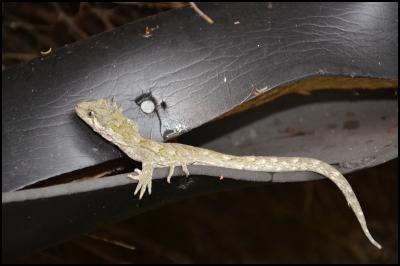Native geckos rehomed on pest-free island
Media release
25 March, 2017

One of eight ngahere geckos
finds a new home under an artificial cover on Mana Island.
Lee Barry / Department of Conservation
Native geckos rehomed on pest-free island
Eight native lizards received a helping hand from Department of Conservation Director General, Lou Sanson on Saturday, 25 March, when they were transferred to Mana Island near Wellington, as part of a GBC Winstone project.
The ngahere geckos will join 28 others previously ‘rehomed’ to the pest-free island as part of a plan to collect and transfer as many as possible from future development areas of Belmont Quarry.
"With the help of many people, these geckos have been safely released in their new home and will boost the numbers of the eleventh lizard species on the island," said Ian Wallace of GBC Winstone.
To allow the on-going development of Wellington's Belmont Quarry, GBC Winstone requested permission from DOC to collect and transfer as many ngahere geckos as possible to a safe haven. All New Zealand geckos are fully protected, meaning that they may only be handled, collected or kept in captivity under permit. It is illegal to deliberately harm them.
GBC Winstone is also contributing to pest control and replanting in the adjoining Belmont Regional Park, and protecting lizard habitat across 10 hectares of their land.
“GBC Winstone are being good stewards of their land – and of this taonga species – by taking responsibility to move them to a safer place,” said Mr Sanson, “Ngahere geckos are an ‘at risk’ species whose numbers are declining. Any individuals that can be saved are a boost for the species.”
The project to relocate the geckos was a success due to the support of Taranaki Whānui, Ngāti Toa, Friends of Mana Island, and Wellington Zoo.
During the translocation process, the geckos had a quarantine 'holiday' at Wellington Zoo, where they received expert care from the vets at The Nest Te Kōhanga.
Local iwi Taranaki Whānui supported GBC Winstones to gift the geckos into the care of Ngāti Toa, who officially welcomed the visitors and the geckos to Mana Island, before the lizards were released into a special enclosure. Friends of Mana Island volunteers, who have restored much of the island’s forest canopy over the past 20 years, built the large enclosure to provide a temporary safe refuge for the geckos to settle in.
The new arrivals will be monitored to make sure this translocation is a success. Checks since the first release show most of the new residents are in good condition and may already be breeding.
GBC Winstone will begin the third and final stage of the project this year, with meticulous searches of the forested hillside near the quarry by day and night, to collect and relocate yet more geckos.
“It’s not easy to find and capture these cryptic creatures,” said Mr Wallace, “but we are committed to finding them safe homes, thereby minimising our impact and hopefully being able to make a net positive contribution to the environment.”
To learn more about New Zealand’s geckos, visit the DOC website.
–Ends–
Ngahere gecko background information
Habitat preference and behaviour
Ngahere geckos (Mokopirirakau ‘Southern North Island’) are found in forest and shrubland around Wellington, the Tararua ranges and Kapiti Island. Generally found on trunks and larger branches of trees, these geckos are occasionally found nearer to the ground in shrubs or ferns, or in creviced clay banks. They spend the majority of their life in the canopy and are mostly nocturnal so are rarely seen.
Threats
There are two main threats to geckos: predation and habitat destruction. Predators include cats, rats, hedgehogs, weasels, stoats, ferrets, possums and pigs. Since most of these predators are active at night gecko species that are also nocturnal are more at risk. Geckos retreat into small crevices where they shelter and sleep.
Although habitat destruction is at a much lower level than it has been in the past, it is still a threat to New Zealand geckos. Forests and tussock grasslands are still being cleared or burned, and developed, threatening geckos that live in them.
Gardening for geckos
You might not see geckos in your garden, but you can help protect them by planting trees closely so the canopy connects allowing them free movement without the need to go to the ground. Encourage vines and climbers up larger trees, place bark under the climbers or tie large pieces of bark onto the tree with biodegradable string.
Geckos will hide in dense foliage in the canopy and these habitats can be mimicked by using hanging baskets in trees. Encouraging epiphytes to grow on trees increases diversity and food for geckos and provides extra cover.


 Gordon Campbell: On bird flu, AUKUS entry fees and Cindy Lee
Gordon Campbell: On bird flu, AUKUS entry fees and Cindy Lee Susan Botting - Local Democracy Reporter: Ruawai Leader Slams Kaipara Council In Battle Over $400k Property
Susan Botting - Local Democracy Reporter: Ruawai Leader Slams Kaipara Council In Battle Over $400k Property Te Pati Maori: Another ‘Stolen Generation’ Enabled By Court Ruling On Waitangi Tribunal Summons
Te Pati Maori: Another ‘Stolen Generation’ Enabled By Court Ruling On Waitangi Tribunal Summons Peace Action Wellington: Die In for Palestine Marks ANZAC day
Peace Action Wellington: Die In for Palestine Marks ANZAC day Labour Party: Penny Drops – But What About Seymour And Peters?
Labour Party: Penny Drops – But What About Seymour And Peters? Government: PM Announces Changes To Portfolios
Government: PM Announces Changes To Portfolios Family First: Just 1 In 6 Oppose ‘Three Strikes’ - Poll
Family First: Just 1 In 6 Oppose ‘Three Strikes’ - Poll


